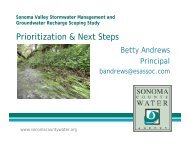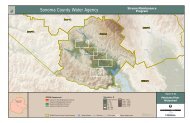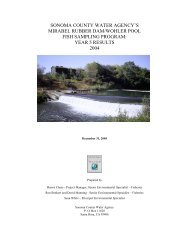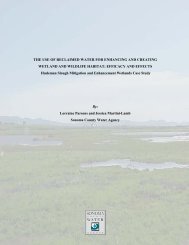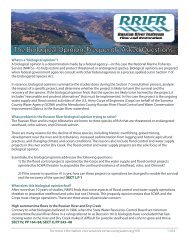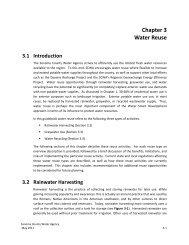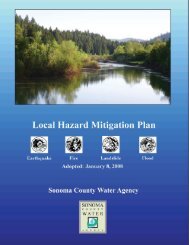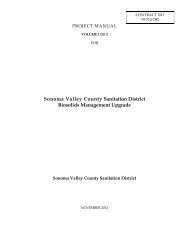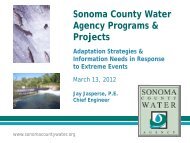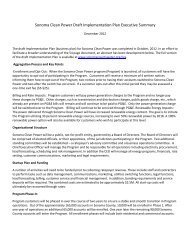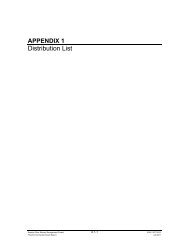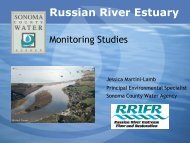Hydrography of the Russian River Estuary - Sonoma County Water ...
Hydrography of the Russian River Estuary - Sonoma County Water ...
Hydrography of the Russian River Estuary - Sonoma County Water ...
Create successful ePaper yourself
Turn your PDF publications into a flip-book with our unique Google optimized e-Paper software.
Figure 3.7). A concurrent drop in estuary temperature and increase in <strong>the</strong> mass <strong>of</strong> salt in<br />
<strong>the</strong> estuary salt mass (see Figure 3.39) indicate that wave overwash was indeed <strong>the</strong><br />
cause <strong>of</strong> <strong>the</strong> water-level change. As wave-overwash volumes are difficult to estimate<br />
without direct data, or data on berm morphology (e.g. height, width), <strong>the</strong>se days were<br />
excluded from water budget calculations. Days were excluded if wave heights exceeded<br />
1.2m (~4ft) or if wave heights exceeded <strong>the</strong> difference between estuary and ocean<br />
levels by more than 0.3m (~1ft).<br />
3.1.3 – Relation between seepage loss and water level<br />
The loss <strong>of</strong> water owing to seepage through <strong>the</strong> sand barrier at <strong>the</strong> mouth is driven by<br />
<strong>the</strong> pressure difference across <strong>the</strong> barrier due to <strong>the</strong> difference in water level between<br />
estuary and ocean. The rate <strong>of</strong> flow Q seep is expressed by Darcyʼs Law:<br />
Q seep = K.A.dh/dL [Eq. 3]<br />
where K is <strong>the</strong> hydraulic conductivity (related to permeability <strong>of</strong> <strong>the</strong> barrier), A is <strong>the</strong><br />
cross-sectional area <strong>of</strong> <strong>the</strong> flow through <strong>the</strong> barrier, and dh/dL is <strong>the</strong> hydraulic gradient<br />
(hydraulic head divided by length <strong>of</strong> flow path). Thus, as <strong>the</strong> estuary water level rises<br />
one expects <strong>the</strong> seepage rate to increase (given that ocean water level changes little at<br />
time scales longer than tidal).<br />
Here <strong>the</strong> loss term from Equation 2 is plotted against <strong>the</strong> difference between Jennergage<br />
estuary water level and 25-hour averages <strong>of</strong> <strong>the</strong> sea level at <strong>the</strong> Pt. Reyes tide<br />
gage (Figure 3.5). The difference Δh produces a better fit with flow loss estimates than<br />
<strong>the</strong> Jenner gage level alone, because <strong>the</strong> sea level is not constant but varies in<br />
response to winds and waves (Largier et al 1993; O'Callahan et al 2007), which have a<br />
different local effect on <strong>the</strong> beach at <strong>the</strong> mouth <strong>of</strong> <strong>Russian</strong> <strong>River</strong> than <strong>the</strong>y do on <strong>the</strong><br />
headland at Point Reyes.<br />
Since Point Reyes measurements do not reflect local winds, nor short-period wave<br />
generation in <strong>the</strong> vicinity <strong>of</strong> <strong>the</strong> <strong>Russian</strong> <strong>River</strong> mouth, nearshore significant wave heights<br />
may be underestimated at times. This makes it difficult to exclude all events when wave<br />
overwash may have occurred – resulting in some points that may be in error (discharge<br />
lower than expected for given hydraulic head). However, as <strong>the</strong> beach height increases,<br />
wave overwash becomes less common (e.g. Donnely et al 2006) and this potential error<br />
is unlikely to be an issue. For <strong>the</strong>se reasons, some outlier data obtained from days <strong>of</strong><br />
intense wind or waves were excluded from Figure 3.5.<br />
19




